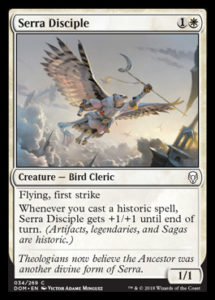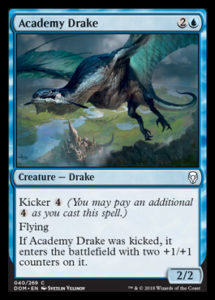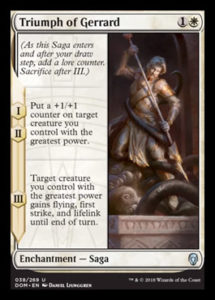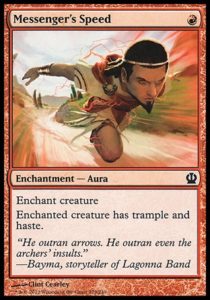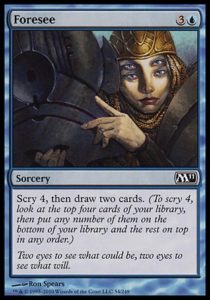Dominaria’s mechanics have all been spoiled, but the majority of its commons remain unrevealed. This gives us a bizarre snapshot of the Limited format: the mechanics tell us how many cards are capable of functioning, but we don’t know their implementation.
Today, let’s talk about the speed of any given Limited format, how that relates to its mechanics, and how gauging a format’s speed has become increasingly difficult.
Dominaria’s Mechanics
Dominaria introduces three new mechanics and two familiar mechanics: Sagas, Historic spells-matter, Legendary Sorceries, with Kicker returning and Hexproof From [COLOR] being a more restricted version of hexproof. These mechanics all encourage different speeds to the format:
Kicker is a mana-sink mechanic. Such mechanics encourage longer games and are almost essential to functional control or slower decks.
Hexproof from [COLOR] is a weaker version of Protection from [COLOR], where your creatures will have some extra oomph a minority of the time and usually be unable to use the ability. It doesn’t communicate much about the speed of the format, other than suggesting that creatures will be slightly less mana-efficient (since every beneficial ability costs something).
Historic spells-matter is an A+B mechanic, where players combine two different types of card to get a benefit. Historic-spells matter involves players accumulating value for each historic spell they play, and such mechanics tend to encourage longer games. Players need to see more cards in order to find the necessary components and they benefit every time they combine them.
Legendary sorceries are another A+B mechanic. However, unlike Historic spells-matter, you don’t get value for each time you combine your components. Instead, you get an overpowered or undercosted spell by jumping through a hoop. This is similar to a cost-reduction mechanic, where you can combine resources to accumulate major advantage.
Sagas are a time-delayed mechanic, where you accrue value over a few (in this case, three) turns. Such mechanics often encourage longer games, since you want to be able to benefit from all parts of your Sagas.
Deceptively Fast Formats
You may have noticed that I used a lot of qualifiers in the last section. This wasn’t to be technically correct or cautious: it was to call attention to how incorrect these statements can be.
A year ago, in the week leading up to Amonkhet’s release, I wrote a similar breakdown of Amonkhet’s mechanics. I concluded that it had the potential to be one of the most flexible and best-designed Limited formats of all time. It had a variety of mechanics that encouraged a variety of speeds—in theory, it was perfectly balanced. In practice, it was one of the most lopsided aggressive Limited formats since Avacyn Restored (and until Ixalan, which continued a trend among Large sets).
Amonkhet had several mechanics that encouraged longer games: Embalm, Aftermath, and Cycling, as well as powerful common removal. All of these encouraged slower games. However, such mechanics can falter if aggro is too good. Their flexibility comes with a cost: you get a worse deal on either half of the card than if you didn’t have the flexibility. Compare Academy Drake with Aerial Guide.
Such as the case in Amonkhet, as Exert dwarfed all the slower mechanics in terms of power. Embalm and Aftermath cards were all slightly overcosted whereas Exert cards could essentially transform into more expensive cards while attacking (but only when you needed them to, offering incredible flexibility and power at a substantial discount). The resulting format was defined by races, and in a format where profitably blocking Exert creatures isn’t possible, the best response was simply to race faster.
Variable Utility
Many mechanics have the potential to encourage faster or slower gameplay. Energy is an alternate resource which players can gather over time and spend powering engines like Architect of the Untamed and Whirler Virtuoso. In practice, it allowed cards like Thriving Rhino to snowball: turn an already advantageous position into an even better position, solidifying one’s grasp on victory. Heroic is an aggressively-focused A+B mechanic where oftentimes a single trigger was sufficient to create an unbeatable threat, so it encouraged faster games rather than the contrary.
All of Dominaria’s new mechanics are so modular. Historic spells-matter could mostly appear on cards that slowly grind out value and push for longer games. They could also provide aggression-focused boons, such as Serra Disciple‘s Prowess-like effect. Sagas could be about accruing advantage as you get the effect of three spells with one card, or you could have Triumph of Gerrard doing an Ordeal of Heliod impression. Legendary sorceries could provide slower mages powerful spells to come back into the game with or they could be powerful one-two punches that allow the winning player to snowball.
I’m not making any normative statements about these mechanics: flexible mechanics that support a variety of designs are among Magic’s greatest mechanics: split cards, transform, and Kicker (and Kicker-like effects, since Kicker is crazy broad). However, I want to caution both you and myself against making assumptions about Dominarian Limited based solely on the mechanics present. Whereas mechanics like Heroic, Exert, Renown, Kicker, Bestow, and Banding are more overt about what styles of gameplay they encourage, others don’t have clear aggressive or controlling bents.
So, How Fast Is Dominaria?
Over the past few years, we’ve seen Limited formats get faster for several reasons, some of them simple. Common removal has been weakened a bit (costing 1-2 mana more on average), Common creatures have gotten a bit bigger (shaving 1-1.5 mana on average). There are fewer abysmally bad common creatures. Black and red have been allowed to get bears without downsides. Common combat tricks have gotten more powerful and are more resilient to being punished by removal spells (since they’re more difficult to hold up in combat by virtue of being more expensive). The truth is, we can’t infer much about the speed of the format until we see what the common creatures and removal spells look like. That said, I can tell you what to look for.
Every format tends to have a magic number or two: the size of a creature that can profitably attack (in most circumstances), the toughness a creature needs to profitably block, and the toughness a removal spell needs to beat in order to kill most things are usually the best benchmarks for solving a format. In Zendikar and Magic 2012, a 2/1 for 2 was an excellent creature. In Ixalan, 3 power was the norm and 4 toughness was necessary for profitable blocks. Kaladeshi removal spells needed to be able to deal with 4 toughness creatures like Peema Outrider and vehicles like Renegade Freighter, meaning only Welding Sparks was the only common removal spell able to profitably trade with a majority of the best common threats. Find the magic numbers of a format and you’re likely to figure it out both faster and with more understanding than everyone else.
I’m delighted to return to Dominaria in a few weeks and for spoiler season to begin in full swing next week. I’m amused that its mechanics are so inscrutable by design—they could do a whole host of things and we’ll just have to wait to find out what they are. Hopefully you’ve enjoyed this little foray through game design and Limited analysis. I’ll see you again next week when we get to sink our teeth into some brand new cards!
And as always, thanks for reading.
—Zachary Barash
Zachary Barash is a New York City-based game designer. He works for Kingdom Death: Monster, has a Game Design MFA from the NYU Game Center, and does freelance game design. When the stars align, he streams Magic.
His favorite card of the month is Heart Warden. It’s a Mind Stone Elf that’s more fair, has more utility, and will hopefully be reprinted sometime soon, perhaps in a Masters set!

